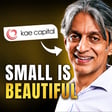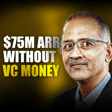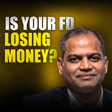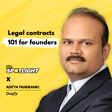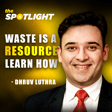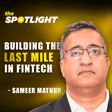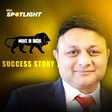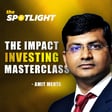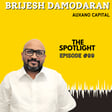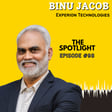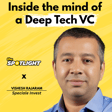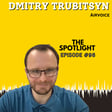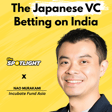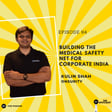Become a Creator today!Start creating today - Share your story with the world!
Start for free
00:00:00
00:00:01

Creating impact through the PE route | Arvind Agarwal @ C4D Partners
Delve into the fascinating journey of Arvind Agarwal, a seasoned Private Equity investor who is now marrying his wealth of experience in traditional investing with the realm of impact investing. Impact investing involves strategically investing in companies that aim to make a positive difference in society or the environment. Explore the nuances of Arvind's transition and gain valuable insights into the distinctions between a PE investor and a Venture Capital (VC) investor.
For more such interesting founder journeys, subscribe to our newsletter www.founderthesis.com
Transcript
Introduction to Equity Investors
00:00:00
Speaker
Hello, everyone. I'm Arvind Agarwal, founder and CEO of C4D Partners.
Differences Between PE and VC Investors
00:00:19
Speaker
Broadly speaking, you can classify equity investors into two buckets, those who invest in public markets and those who invest in private equity. As an example, a mutual fund is a public market investor that invests in listed stocks. Private equity investors are further split into two broad buckets, SPE investors and VC investors. By the end of this episode of the founder thesis podcast,
00:00:43
Speaker
You will have a deeper understanding of the difference between a PE investor and a VC investor, and you will also understand the mind of the PE investor. Arvind Agarwal is a veteran PE investor who is marrying his deep experience as a PE investor with Impact Investing, which is basically the practice of investing in companies that are creating social or environmental impact. Stay tuned for Akshay's fascinating conversation with Arvind Agarwal in which he learns how to think like a PE investor.
Arvind's Journey to Private Equity
00:01:21
Speaker
So you've been a veteran of the PE VC space. Just take us through your career path. What led up to you starting your own fund? Sure.
00:01:34
Speaker
So I'm not sure about the veteran, but definitely sure about my experience in the PE space, but not the VC because in my mind, there's a very clear distinction between the two strategies. My journey started quite sometime back, Akshay. I was 15 and I come from a moderately economic background and from a very small town called Purulia. And at the age of 15,
00:02:01
Speaker
you know things were financially not looking that great and I was looking for an escape route and that's where I stumbled upon an English newspaper and the front page of that had a article about a private equity firm I don't remember the name I don't remember the name of the person the picture I saw but that person looked you know
00:02:21
Speaker
quite happy to me and rich. And at the age of 15, these are the two things I wanted. I wanted to be happy. I wanted to be rich. This was the era, no internet. And in my mind, I decided I'll be a private equity professional. Didn't know how. Fascinating. Fascinating. I'd like to share one quick anecdote here. I have interviewed another VC founder, and he had a very similar story that he watched Pretty Woman.
00:02:48
Speaker
and the character of Richard Gair in Pretty Woman is like a PE fun guy and that is what influenced him. So this seems to be some sort of common theme between people who get into the PE VC space. Yeah, this was the era we didn't have access to English movies. So maybe, you know, I would have been inspired much before than the age of 15. But yes, the journey started from there. You know, it's been 28 years now.
00:03:17
Speaker
Wow, okay. So just like a quick summary, what did you, what organizations, what roles, what did you learn in each of
Career Path to Goldman Sachs
00:03:25
Speaker
those?
00:03:25
Speaker
So after my post-graduation, I joined E-values of India Private Limited. It's a third-party research organization based out of headquarters in Gurgaon. There I was doing research for two Asian-based private equity firms. This was an outsourced research, so researching on the companies they are looking at. This was a short stint, and then I moved to Goldman Sachs Private Equity Group. This was 2007. That was my longest
00:03:54
Speaker
How did you crack Goldman Sachs? I would have thought you would need like some pedigree of like an IM tag and all of that. Yeah, so that was also an interesting episode Akshay because you know, a lot of people applied for and it was a founding team which was put together by Goldman Sachs in Bangalore in 2007. The idea was that this team will kind of be a back office for the main teams which are sitting across the globe.
00:04:23
Speaker
When I applied for Goldman Sachs, it was a long run process, five rounds of interviews. And then after 10 days, I received a call saying, hey, you didn't make it. So obviously I was rejected because Goldman Sachs was one place I wanted to be. Then after a week or 10 days, I received the call again from the consultant and she says,
00:04:44
Speaker
Hey, you made it. I like, what happened? They said, no, you were actually, they were hiring three people. You were the fourth one and one of the three people declined to take the offer. So it went to you and super excited and joined and very quickly in three months, you know, the roles changed from, you know, just being a captive and become
00:05:04
Speaker
More like a diligence in the funds researching the funds working with the fund managers So if I think on day one if the objective was that it will be a front-ending team Probably I would not have made it because I don't have a you know I am or a Ivy League tag with me which usually you see with people in this part of the world Okay, and what what was your role there at
Role at Goldman Sachs
00:05:28
Speaker
Goldman Sachs? What did you do?
00:05:29
Speaker
So I joined as a senior analyst and primarily this department used to look at investing in fund managers. So we were investing in funds across the globe and direct co-investments. I did that for four years and then moved to hedge fund of funds. So Goldman Sachs had its own fund which was deploying the strategy.
00:05:52
Speaker
It was Goldman Sachs own fund of fund. So just like a GP, they had raised money from big LPs for this fund of fund. And the main objective was to invest in private equity and private equity funds and hedge funds.
00:06:07
Speaker
Okay, this would be like creating an index fund in a way. Not an index fund as such, but it is like creating a mutual fund, raising money from endowments and insurance companies and then investing in fund managers.
00:06:23
Speaker
Okay. One quick clarification before you tell me about the hedge fund role you did at Coleman. You said that there is a very clear demarcation between private equity and VC. What is that demarcation?
PE vs VC: Cash Flow and Speculation
00:06:39
Speaker
Because the very same company on its capital might have Sequoia, which is clearly a VC and might also have maybe I guess General Atlantic would be like a PE or
00:06:52
Speaker
So, you know, or like maybe Westbridge would be a PE. I don't know. I mean, I'm not fully clear, but I know that on the cap table of one startup, both can exist in parallel. So what is the clear demarcation between a PE and a VC?
00:07:06
Speaker
See, both can definitely exist in the capital of a company. It's about the role or the strategy once execute. The line between P and VC is getting blurred day by day. So if you look at traditionally what used to happen as company starts and they were raising money from friends and family, angel round, and then they approach a VC fund.
00:07:29
Speaker
VC takes the largest risk at that point in time with a higher check because the product is not ready and most of this investment is going to create the product. You know, technology and VC kind of goes hand in hand. So it was always funding for the development of the tech product. And once the product hits the market and company turns profitable, it's cashflow positive, PE walks in with a larger check for growth of the company.
00:07:56
Speaker
Now what has happened is, particularly if you see in India, we see invest and it's not to fund the product development, which is a technology play, but it is more to fund the OPEX losses and this has become a never-ending process.
00:08:13
Speaker
The company is not operating cash flow positive. A PE will not walk in. And which is why you see now larger VC funds and they call themselves late stage VC. And another interesting thing which is happening here is a lot of PE funds are now seeing, hey, we are losing out on opportunities because most of the deals which are going to the growth stage, we can't do it. It's not cash flow positive.
00:08:34
Speaker
So, there is this concept of early stage private equity, which is common, where P kind of comes in early stage. And if you look at us, we are also an early stage private equity fund.
00:08:47
Speaker
Okay, interesting. So you're saying traditionally a PE looks at cash flow positive businesses. So it's looking at the business the way a public market investor is looking at a business, the fundamentally strong profitable business which will return, which will give a reasonable return on investment. It's not taking like big bets that okay, I will invest in 20 and out of them one big bet will happen and it'll make up for the 19 bad bets.
00:09:16
Speaker
Exactly, so number is slightly different. P usually works in a fund 15 to 20 companies and all the companies are as important as any other company in the portfolio because they can't tend to lose portfolio companies from their bucket.
00:09:32
Speaker
the portfolio and you know one or two will go down but majority of the portfolio will drive the return for the fund. Whereas on a VC if you see it's more of a you know spray and pray where you will probably do 40 transactions and you will pray that four of the 40 turns out really well and that will kind of recook all the returns for the other investments that has gone down.
00:09:57
Speaker
So it's also about the focus and which is why PE funds focus quite a lot with respect to operations, management, strategy. That's another reason why they can't have a larger portfolio because it's very difficult to be operationally and strategically involved with a large set of companies in your portfolio.
Venturing into Early-stage Investing
00:10:16
Speaker
Right. Okay. So a PE fund would want to carefully look at numbers and advice management based on what they see on the numbers and like take a more active role as a consultant to the founders or the leadership team. Okay. How, you know, you were responsible for deciding which fund manager to back at Goldman Sachs. What's the way in which you evaluated and took that decision?
00:10:43
Speaker
So, actually the analysis split into two parts, one is the qualitative and the other is the quantitative. On the quantitative, we look at the past performance, there is a lot of slice and dice which is done with respect to the portfolio companies of the previous funds to understand
00:11:01
Speaker
which partner, which geography, which sector, which strategy kind of worked for the fund and again the fund and lot of those type of analysis is done including value creation. So, you know, unlike a VC fund in private equity, it's all about the operational efficiency and the operational growth. So, we do something called value creation analysis where we try to understand how the value was created in the company
00:11:29
Speaker
Was it by increasing the EBITDA or is it just by reducing the net debt or it is just increasing the multiple of EBITDA or revenue that we are using? So a lot of those type of quantitative analysis happens and then qualitative to understand the market, the strategy which the fund manager is executing, the team strength, you know, things like that.
00:11:54
Speaker
So these are a set of two analysis that we do to understand which fund manager to back versus which to ignore. And is there also a consideration that, OK, we already have one fund manager who's focused on tech startups in India, so we will not back another fund which is on the same, like diversification,
00:12:21
Speaker
So high level diversification happens. So the way fund of fund also works, because just like a fund, there is a strategy of the fund of fund. So fund of fund will not say, hey, I'll just pick one of each. So the fund of fund strategy could be backing tech VC funds in India. So there are some diversification might come with respect to sectors, sub-sectors, but that will not be huge.
00:12:50
Speaker
So all the 20 or 25 fund managers in that fund of fund would be tech VC. Some might be deep tech, some might be working on health tech, things like that. But all will be quite similar with respect to tech exposure. Okay. Okay. And so after the first four years, you said that you went into a separate division. What was that?
00:13:14
Speaker
So, after first 4 years, I went into the hedge fund of funds division of Coleman Sachs and here also so, a bit of a background here which is very important to where we are today as a country when it comes to private investment. So, this team was put together in 2007 and you know and that was the time when the idea was that private equity in India will become big.
00:13:38
Speaker
We joined in May and if you remember there was a financial crisis which happened 2007, December and 2008, January. Unfortunately, at that point in time, a lot of PE funds in India, they had a high amount of exposure with respect to public investments, which is in our language called PIPE, Private Investments and Public Enterprises.
00:14:02
Speaker
2008, when the crisis happened, a lot of these fund managers kind of doubled down on their public investments. And as you would know, the markets remained choppy for a couple of years after that. And that led to a bad
00:14:18
Speaker
reputation for private equity in India and the private equity didn't grow as it should have grown in the past decade. Then for us you know it was more of working with fund managers outside of India and that was not the main objective of the you know the team which was put
00:14:37
Speaker
And that's when in 2011 Goldman Sachs was kind of deciding to shut down the team for private equity in India and that's where I moved to hedge fund of funds. Public market was growing though hedge fund again in India is not big but globally it's a very big market and that's how I moved to hedge fund of. What's the hedge fund?
00:15:01
Speaker
So, hedge fund can have different strategies. There are four broad strategies that you see hedge fund managers execute, but it's mainly dealing with public market. So, you can be dealing in debt instrument, currency could be one strategy, equities, you have different strategies. So, it's largely two key aspect, I would say. One is public market.
00:15:28
Speaker
And two, these are very high risk bets. So unless a PE fund, where if you have $1, you invest $1, a hedge fund will invest $100 when they have $1. So you can see your entire capital wipe out in a day, or you could make 100% return in a day. OK. So they would take more leveraged bets using options and futures
00:15:57
Speaker
OK, OK. Hindenburg, which had gone after Adani, is also a hedge fund? No, it's not a hedge fund. It's more of a mix terminology you can give them because one, they call themselves a research organization where they kind of do these type of research. But Hindenburg, they actually take an exposure before making the research public. So there is a vested interest as well.
00:16:25
Speaker
So if they don't do typical hedge fund work, but you know this what happened on the Adani episode, this is more of a, you know, you can do better research, but before you make your research public, you will take your own bet. So you also, you know, gain advantage, not just because of the research, but also the market sentiment that you are creating.
00:16:49
Speaker
Okay, okay, okay. Plus it gives you skill in the game in a way like your research will be seen as more credible if you're putting money behind it. Yeah, but hedge fund managers on the other hand, they have their own research when they take their bet, but they never make that research public. Okay, got it. Okay. Okay. I think there was another
00:17:13
Speaker
Wirecard in Europe, I remember reading an article about how a hedge fund ultimately kind of exposed them. They had done deep research and discovered that Wirecard was a fraud. Yes, hedge fund is a, I don't know how to, what should be the right word, but it's a
00:17:31
Speaker
very difficult and sketchy business as such because of the strategy they follow and the type of returns they make. I mean not one, there are many instances in the past which has happened where hedge funds are total fraud with respect to how they operate and all and not all hedge fund managers.
00:17:52
Speaker
the probability of you know something happening wrong is quite high given how close they keep the cards to their chest about their strategy, what they are doing, their transactions. So a lot of you know I think for them it's very important for a lot of transaction that the information don't go out and for a lot of transaction it makes sense that the information go out.
00:18:17
Speaker
Okay. Got it. Right. Okay. So then you were into a fund of hedge funds, like you were backing hedge fund managers for Goldman Sachs. Yes. So that was again a short stint. And by that time I was already too much into private equity. So it was, you know, then the question which came to my mind, what's important to me, what I do or where I do.
00:18:42
Speaker
And what I do was more important than where. So I started looking out and then shifted to Middle East Abu Dhabi and joined the local private equity fund manager based out of Abu Dhabi. I would not have ever left Goldman Sachs because that was one organization. I really enjoyed my time. So if it was not for the fact that the private equity is shutting down in India, I would have probably remained there.
00:19:11
Speaker
But private equity kind of by that time, it was more than a dream of a 15 year old child. It was something I was thoroughly enjoying. Okay, so and that Abu Dhabi PE was investing well in India? No, not India. So we were investing in GCC countries. Direct investments were done through one of the funds.
00:19:39
Speaker
We were also doing real estate investments in UAE and also London. So we had a listed entity in London. And third, we had what we call a secondary fund of fund. So the secondary fund of fund is different from a primary fund of fund in the aspect that a primary fund of fund is when I invest in a new fund, you know, our manager is launching. It could be the third fund, fourth fund, but I am an investor from day one.
00:20:08
Speaker
And as you know, private equity investments are illiquid. You are locked in for 8, 9, 10 years. Our Secondaries Fund of Fund actually buys the LP stake of an existing fund. So we also had a Secondaries Fund of Fund at Goldman Sachs and at Abu Dhabi Capital Management, where we used to buy the LP stakes of other funds. And you would probably get some discount in return because you're providing liquidity.
00:20:34
Speaker
So, depending on the quality of the fund managers, the discount would vary from 90 percent to even a premium.
Founding of C4D Partners
00:20:42
Speaker
So, there are some cases where we actually gave a premium, but largely you would see a discount of 40, 50, 60 percent when buying the stake. Okay. Interesting. Okay. Okay. Right. Then what next after the Abu Dhabi East End?
00:20:59
Speaker
So again, it was a short stint because though I was enjoying my work, but the work culture in UAE is something which I was not able to gel well. And after some 13, 14 months, I decided I was quite done. It was almost eight, nine years and P.
00:21:21
Speaker
Space is, you know, it takes a toll on your health, be it physical or mental. And I was at a stage in life where I was like, I've already worked for 16, 17 years, you know, eight year was equally went to 16, 17. I said, let me go back to my hometown and try to do something of my own. And I went back to Dhanbath, which again, I call hometown, but that's not where I'm born and brought up.
00:21:49
Speaker
It's just my family, siblings and my parents, they moved. I was born in Bengal. So I moved to Dhanbad and I started a rural PPO. So I went there and I, you know, kind of started looking around what to do. I realized there is a big population of youngsters who are graduates, who are, you know, engineers, and they are working in Calcutta. And at that time, most of these people were getting a salary of 15,000, 12,000 a month.
00:22:18
Speaker
where almost 60-70% they were spending on food and housing. They would have any day wanted to work in their hometown where their families are and work for us, you know, 5,000, 6,000, 7,000. And these people were computer literate. So easily, they can do conversion work, non-voice processors.
00:22:44
Speaker
So I started that and it was a total failure, 13 months. I tried to establish a business, but didn't succeed. Was it that you were not able to get business or was it that you were not able to execute?
00:23:00
Speaker
So, it was mix of challenges, Akshay. One, I was a single person kind of do everything with respect to operations, business development, getting new clients. The business community or the way business work in Eastern India is very different than what we are used to, right. Being in the PE space or my career at that time, there are certain level of expectation, there are certain level of commitment which are not to be said. Eastern India is a very different
00:23:30
Speaker
business community. So that was also one of the reasons. You could have got business from you in Airtel or you know any any national player because this is yes we were actually I was trying all those things in fact that was the time when you know post office digitization was happening so all the post office records were getting digitized FIRs were getting digitized unfortunately all these contracts you can only get as a subcontract you know you're not a big player to get a main contract
00:23:58
Speaker
And when you get a subcontract, which is what I had, you are dependent on the main contractor with respect to your payment. And the way they take decisions with respect to how much they're going to pay you and when, and whether they're going to pay you or not, it's very different business. Yeah, I can imagine that's a cash flow challenging business. I mean, working with government is profitable, but cash flow challenging.
00:24:25
Speaker
Yeah. And this was, this was not also, you know, directly working with the government. It's like, yeah, exactly. And plus they will then not pay you on time or they will not pay you at all. And one invoice not getting paid, you know, you're losing too much money. Right. Right. Right. Okay. Got it. Okay. So what then, like, once you tested failure? Yes. I tested failure, but I,
00:24:52
Speaker
I think of all my career, the 10 years that I spent, this was one and a half years where I enjoyed the most. Surprisingly, every day was a challenge, but every day I was happier. So I realized that this is where the happiness lies for me, or this is what I enjoyed the most. So then the idea was, how do I merge
00:25:19
Speaker
the two things that I really like in my life. One is investing and the other is early stage. And at that time, I also realized Akshay because see, when I joined my first job E-value serve, it was a one and a half year old organization. So pretty much kind of a startup. Goldman Sachs was an organization which has been there for ages. But this was a new team which was set up in Bangalore.
00:25:48
Speaker
Similarly, my Abu Dhabi, I joined them and it was a one year old organization. So somehow I was in that zone of one, two years type of older organization or team. And that's what I realized when I failed in my venture that this is one space I enjoyed.
00:26:07
Speaker
So, I started looking out to see if I can merge the two and there has been a gradual decrease with respect to check size. So, in Goldman Sachs, the average check size was 50 to 100 million dollars.
00:26:20
Speaker
At Abu Dhabi, the average check size was 5 to 10 million dollars. So then I started looking for opportunities and that's when I came across eco-investments, which is a former name of C4D partners. Check size, half a million. Early stage investing, working very closely with the founders. And I thought this is something which is kind of ticking both the boxes.
00:26:47
Speaker
But at the same time, one year stint, which I had in Dhanbad, I also realized the impact that these businesses can make. I hired 15 people in my organization. All 15 were very happy. I was not able to pay them for the first two months. And they still turned up for the third month. They said, no, no, we want you to be successful. Because if you are not successful, we will have to go back to Calcutta. And we don't want to have that life. In fact, after a year when I shut down and I joined Eco,
00:27:17
Speaker
you know, some of those employees kept on calling, are you thinking of doing something else? And then, you know, we would really like to come. So that was another angle which I understood, to be honest. Before that, I didn't understand, you know, this angle, writing a 50 to 100 million check and being at Goldman Sachs, you don't really understand what goes on the ground with respect to rural. So eco investments or C4D Partners 2014, it kind of ticked that box as well.
00:27:47
Speaker
And that's where my new journey of impact investing started. What was the thesis of Eco? So Eco is a Dutch NGO and primary funding for them was the Ministry of Foreign Affairs in the Netherlands. So it used to be a five-year budgeting and they used to get money from the government to execute project.
00:28:11
Speaker
In 2010, they already knew that the next year budget, the next that is 2015 budget is going to be significantly lower. So, they wanted to diversify businesses. So, they started an investing called impact investing, eco-investment with the idea that this fund will support private companies which will help with their projects that they are running in the country.
00:28:39
Speaker
So it was very much internal looking strategy which was that for eco and eco investment was a subsidiary which I joined in 2014. However, soon we realized this is not doable. Investing has to be disciplined and it has to have its own autonomy.
00:29:00
Speaker
you can't invest money with an objective of, you know, working or supporting a project, not for profit project for the organization. And 2016 we realized this and 2017 I kind of spun out of eco and became an independent fund manager. That's where the name changed to C4D partners or Capital for Development partners.
00:29:26
Speaker
And what does it mean to spin out? Like you bought out their share or like what does that mean when you say you spun out? Yes. So basically 100% ownership earlier was with eco-operation and then I kind of bought out the shares and it 100% shareholding came to the team. Okay. And you had other co-founders with you?
00:29:55
Speaker
Yes, so I had other co-founders from the Netherlands, you know, who were part of eco-cooperation at that time. And they also, so the entire team kind of came out and me and my partners kind of acquired the shares. Okay, and I'm guessing this would have been nominally priced. Nominally priced, yes. Right, because their goal is to make it a success rather than to
00:30:22
Speaker
get a return on credit. Okay. That's okay. And, and some corpus also came along with that. Yes. So before that, we were investing from, you know, the balance sheet of eco-cooperation. And at that time, we also kind of realized, because we were trying to fundraise in that fund, which was there by eco-cooperation.
00:30:47
Speaker
And there were three challenges we realized. So at that time, it was a global fund. We were investing in Africa, Latin America, South Asia, Southeast Asia. So when we started talking to LPs, three main concerns came. One, the ownership of the asset management entities with another institution. And that's where we kind of spun out. The second was a global fund. LPs want the fund manager to have skin in the game.
00:31:17
Speaker
Yes. So, you know, because of the, yes, that was not the case. If GP is not owning the entity, they will leave any point in time and that puts the fund or the investment at risk. The second was a global fund. So, none of the LPs were ready to invest in a fund, which was investing globally. It was too widespread.
00:31:43
Speaker
That's when we also decided that we will not invest globally. We kind of shut down operations in Africa, Latin America. We cut down a lot of countries in Asia, and we said we'll focus on three countries, India, Indonesia, and Philippines. The third concern at that time was that it's an open-ended fund. So the fund which we were
00:32:06
Speaker
trying to raise money for that did not have a fund life it was you know kind of a company structure you could say. So, that is when we also kind of launched our first closed ended fund in 2017. So, these were the three main concerns which we addressed and we closed our first fund in 2018 a 30 million dollar fund.
00:32:30
Speaker
Okay, amazing. And this $30 million was from what kind of LPs or limited partners? And just for listeners, so like a limited partner is the one who gives money to the fund manager and the fund manager invests it on behalf of the limited partner. And in return, the fund manager gets to keep some amount of profit share plus some management fees based on how much money he is managing.
00:32:56
Speaker
That's correct. So LP kind of invest in the fund, which is managed by the GP or the general partner. And they're entitled to management fee for running the operations and a share in the profit, which is generated by the fund. And typically management fees is like a one, 2% kind of a... Depending on the size of the fund, yes, it ranges between one and 2%.
00:33:21
Speaker
And the profit share is I think about 20% or something like that in that range. So traditionally 20%, but now depending on, so, you know, you see a lot of different combination and I'm talking about really successful big funds where you would see that some manager will say, hey, I'll charge 1% fee because it's a big fund, but I'll charge 30% carried interest or the profit share. So that is something also you see quite a lot.
00:33:49
Speaker
Okay. Okay. And typically there's a like a hurdle rate you have to cross, like you have to generate some minimum return on investment before you are entitled to a profit share. Yes. So there is a hurdle rate always with respect to the profit share. And it could again range between eight to 10% is what you have to first generate return for the LPs. Once you have crossed that hurdle, that's when you are entitled to take the profit share.
00:34:19
Speaker
And how is the return calculated? Because if these are not publicly listed assets, you could put any number on it in a way. So how do you calculate the returns? Yeah. I think we can do a separate podcast just on this topic. How do the valuation of these companies work?
00:34:45
Speaker
See, for a private equity, it's relatively easier because, as I said, these are cash flow driven transactions. So when there is stable cash flow, the valuation becomes more or less, you can have a ballpark figure. You'll never be accurate, but the ballpark figure will be good to use. The challenge is when it's a VC portfolio.
00:35:12
Speaker
Then the creativity that you can have with respect to valuation of this investment is quite wide. So, I often say this when we were growing up and studying that this terminology or this line you always heard that valuation is more of an art than a science. In current scenario, it is just art, science has gone out of the window. So, the bigger artist you are, the better valuation you can get.
00:35:41
Speaker
But having said that, and which is why the need of auditors also come in for checking or cross-checking the valuation and agreeing largely, these are fine. But again, for anybody, be it the fund manager or the auditor or the LP or anybody else,
00:36:04
Speaker
saying what is the right
Impact Investing Strategy
00:36:06
Speaker
valuation. I think the investor in that company is the right person to say as long as they are not being too artistic. I think they are the one who will get the valuation right. But yes, there are a lot of gray area when it comes to valuation.
00:36:25
Speaker
But sooner or later this is going to come out, right. If you are, you know, if you put a very high valuation on the paper for a lot of your companies today, it will going to hit you tomorrow.
00:36:38
Speaker
So, it is not like you will get away with it in the short term, maybe you will get away with it, but in the medium to long term it will bite you back. And if you know as an LP for example, when we were talking about my Goldman Sachs days as an LP if I see that this is what is happening for the all the funds in the past for that fund manager.
00:36:57
Speaker
So, that is also an underwriting condition that we look at that okay this manager has a habit of allocating a crazy amount of valuation in the past to have a high NAV. So, yeah that also you know works for your longer term where it will not help you.
00:37:14
Speaker
Okay, got it. So this 30 million that you raised for your fund one was from what kind of LPs, Indian LPs, or did you go global? And what was the, and this was like an impact investing focused fund. So you would have pitched to LPs that your money will create impact.
00:37:35
Speaker
Yes, so see I will, so first maybe LPs were non-Indian because this fund was raised in the Netherlands and it would have been difficult for Indian LPs to invest. We raised money from Dutch DFI, Dutch Good Growth Fund. Eco Corporation also became our LP in the fund and the third LP was Fincherchett Fund by Finnish Government and the fourth was Investing for Women, another fund by Australian Government.
00:38:05
Speaker
So these were the four investors that joined us in our journey. For me, because I came from a private equity background and the first four years in the space, I kind of observed what is happening and how the space is shaping up.
00:38:23
Speaker
So, this is what I noticed, you know, when I joined in 2014, you know, this was my first exposure to impact investing. And that time, the shift was happening from not-for-profit or grant making to impact investing. A lot of organizations were kind of reorganizing themselves to do impact investing.
00:38:45
Speaker
However, a lot of underwriting at that point was still done by people from the not-for-profit sector because the space was not big, the salaries were not high, and a lot of professionals in the investing space didn't want to join. In fact, when I also joined in 2014, I took a 70% cut on my two-year salary, which was two years back.
00:39:10
Speaker
So, that time I realized a lot of underwriting is happening with respect to project perspective, three years, four years vision. And that created an issue with respect to one that the social enterprises or impact investing is not scalable and it is not profitable. The only sector which proved with respect to performance was financial inclusion that got money from grant impact
00:39:40
Speaker
commercial investor went for IPOs and now you see financial institution or investor in financial institution are kind of repeating what has been done and trying to make money. But this was a period of MFI's. MFI's, yes. And so which is why that was a period 2014 to 18. I also saw LPs or investor forcing the GPs to move beyond financial institution or MFI's.
00:40:10
Speaker
That's when other sectors open up like agriculture, education, healthcare. Now, unfortunately, by that time you saw a lot of professionals coming in and a smaller fund size and it was all early stage investing.
00:40:25
Speaker
And by default, the strategy these funds adopted was that of a VC. So, we will invest in this many companies. It was more of underwriting with respect to top line and not cash flow positive. See, these companies are not going to raise money every year.
00:40:45
Speaker
When you are working on bringing about systematic change to something, it takes more time. And this is not like all of a sudden tomorrow you will start getting commercial capital. So that kind of created an issue where scalability and exits were not happening in all these studies.
00:41:06
Speaker
and which is where the shift all of a sudden became a VC type of play and then everything has to have technology. So, there was no talk about education, it was at tech, there was no talk about healthcare, now it is health tech and so on and so forth. When we did our fund, what we wanted to prove with respect to strategy was that to be successful in India in early stage investing, particularly when you look at impact investing,
00:41:33
Speaker
you have to adopt more of a private equity approach than a VC approach. So all our underwriting was from a private equity lens. The companies might not be profitable, but they have clear path to profitability in the next 12 months. And then there is a balance between growth and profitability. It will take more time, yes, but we are not going to lose companies because they are not financially sustainable and which we were able to prove.
00:42:00
Speaker
So, the strategy was completely woven around, you know, how do you execute a portfolio. And coming back to your point also, so, you know, one, if you do not lose a lot of companies, you are not losing the impact those companies are creating. Two, if you are not taking unnecessary risk and the portfolio construction. So, if, you know, our portfolio construction is that we do not lose more than 20 percent of the portfolio, which is also typically you see in a P.
00:42:29
Speaker
There will be 30-40% of the portfolio where the growth will not be exponential. They will not raise money year after year, but these are cash flow positive companies. So you can still get an exit through management buyout where you try to recoup the capital at least and if possible also the hurdle rate. And we in our portfolio of 13 companies in India already have done four such exits where it's a management buyout.
00:42:57
Speaker
The third set of the portfolio is the ones which are growing exponentially raising capital every 12 or 18 months, but these are cashflow positive as well not losing money, profitable companies, but faster growth. There you will exit through financial or a strategic buyer, again making an IRR in the range of 30 to 40 percent.
00:43:18
Speaker
So, if you are only losing 20 percent of the companies getting capital and hurdle recouped from the second bucket and a 30-35 percent IRR from the third bucket, at the fund level you can easily do an IRR of 25 percent which by the way the struggle for most of the VC fund also. So, if you take out the top quartile VC funds which are pure play tech type of play, you will see the 25 percent is struggling.
00:43:48
Speaker
So you don't have to do anything crazy. Because this is one thing which I learned in my short stint in my hometown when I was working on the rural BPO. At that time, when I put in investment, I was kind of calculating in my mind that if I have a 10-seater BPO, what is my net profit? And I was looking, if I have a 20-seater BPO, then what is my net profit? So I was looking at the upside.
00:44:18
Speaker
focusing on lot on the downside. I would have been much better if I had a five-seater or a two-seater BPO. So that's where I realized that it's all about protecting your downside and then you work on creating the upside. Okay, interesting. These, the 30 million, how long did it take you to deploy it? Are you still on fund one or have you deployed that?
00:44:45
Speaker
So we are almost fully deployed. We have deployed. We have a very small dry powder, which is for fall on investment. We were last year, by late last year, we were completely deployed with 10, 15% of the capital left for fall on. That's when we launched our second fund. Unlike our first fund, which was investing in three countries, second fund is 100% dedicated, $75 million fund, which we are raising right now.
00:45:15
Speaker
The strategy with respect to the portfolio construction, our thinking remains the same. The beginning or the initial check size also remains the same as the higher end of the check size, which will change because of the fund size. And our existing investor has also committed to invest in that fund.
00:45:37
Speaker
And existing investors alone won't be enough, right? Because this is like the double of the last fund you raise. So you would need to. And you'd be looking at a similar kind of LPs like sovereign wealth funds and like these kind of funds which have a development agenda.
00:46:01
Speaker
I mean sovereign wealth fund and all you know usually are quite big so it is more of a you know what we call the development financial institutions which are usually put together by the individual countries. They have more of a development agenda and see for us getting the right LP is also very important because
00:46:22
Speaker
What we also did on day one, we wanted to change the status quo with respect to how people look at the structure of a fund. As we were discussing earlier, 2% fee, 20% carried interest, 10 years fund life, 5 years investment period. It has become so standard. Nobody is applying or thinking that whether this is what the market needs in India. This is something which worked in the West and we blindly copy pasted this to India.
00:46:52
Speaker
So, one of the things which we did in 2018 when we had the first one, we linked our gender goal. So, we have a strong focus on gender investing. We committed that 30 percent at least of the portfolio or the AUM has to be invested in women-owned led enterprises. If we are less than 30 percent, then we lose carry percentage. And if we are more than 30 percent, then we gain carry percentage. In our first one, we have invested 42 percent of the AUM in women-owned led enterprises.
00:47:22
Speaker
which means we are at a carry of 25%. So it's very important for us to reach out to the right set of LPs who are ready to bring this systematic change when it comes to the structuring of impact funds. So we are mindful about which are the LPs that we are reaching out to who would be ready to make these type of changes in the fund structuring for impact investing.
00:47:47
Speaker
Okay, okay. Would you also be targeting like say the Bill and Melinda Gates Foundation and I think there's a Dell, Michael Dell Foundation and such philanthropic arms of billionaires? Yes, so apart from BFI's, we are targeting foundations as well. Those also have good orientation.
00:48:13
Speaker
But however, we are very clear we will not take any grant money in the fund. It has to be, you know, every every LP in the fund has to be on equal footing. So there are a lot of foundations we are in discussion with.
00:48:27
Speaker
As a next step, once we have had the first closing, we would also like to see the Indian family offices joined because that's another big pool where the orientation of impact investing is still not there because if the family offices don't start looking at impact investing, then I think the impact funds will be largely dependent on foreign capital, which is not the right thing in the longer term as well.
00:48:55
Speaker
Why isn't impact investing mainstream? You explained to me that you're able to generate a 25% IRR or internal rate of return, which you told me is more than what the bulk of funds are able to generate. So I mean, you're actually in like the top percentile in terms of IRR. Why isn't this mainstream? I mean, what's holding it back?
00:49:23
Speaker
So multiple reasons, Akshay, as I said, you know, there was this period between 2014 to 2019 where a lot of money flew into impact investing and the way it was executed earlier.
00:49:37
Speaker
you know, didn't turn out well. And I call those teething problem. And then all of a sudden impact investing became VC investing. It should have been other way around. VC investing should have become impact investing. But impact investing kind of became VC investing and everybody started clapping, hey, the two worlds have merged. So it's not two worlds have merged, it's you cease to exist kind of a situation. So there are two sets of investors, I would say.
00:50:05
Speaker
one who are disappointed that you know something like this has happened where there is no longer any impact fund and it all moved towards VC investing and the second set who wants to focus more on the commercial side of things. So we kind of you know the sector lost both.
00:50:23
Speaker
I go to somebody who is you know into impact investing the moment I call we have an impact fund they will like always question one either you will fail to deliver with respect to impact and a decent financial performance or I am going to operate like a VC in the garb of impact investing.
00:50:44
Speaker
Okay, got it, got it. Is an ESG fund similar to an impact fund? And ESG stands for environment, social governance.
ESG vs Impact Investing
00:50:56
Speaker
And these are funds which are investing. I guess the difference, these funds typically do public market investing, right? They don't do private market investing, an ESG fund. No, actually, so, you know, first thing first, ESG and impact investing are two completely different things.
00:51:14
Speaker
And there was a lot of interchange, you know, people were using both these terms interchangeably quite a lot. And which forced me to write an article around it where I says ESG investing is not impact investing. What is the different schedule?
00:51:29
Speaker
So there are a lot of differences. See, when ESG investing is more about assessing your risk, you know, when you're investing in a company, so you look at and which is why you see, you know, a lot of public companies falling into that purview of ESG because it's large corporate, large companies, the impact on ES or G could be significant.
00:51:55
Speaker
When you're talking about early stage investing, companies that are one year, two years, three years. One second, sorry. An ESG investing thesis is that companies which today might have similar cash flows or similar EBITDA percentages
00:52:13
Speaker
would in future differ based on how much they are cognizant of ESG risks. So a company which both companies are earning the same amount of cash, but if one company is more cognizant of ESG risk, then it has a brighter future. So you invest in those companies which are cognizant of what is the environmental risk of their business or the social risk or the governance levels. That's the thesis.
00:52:40
Speaker
That is the thesis, yes, when you look at the higher level. But this is when we look at ESG versus impact investing, ESG is more backward looking. You look at how the company has been operating in the past years and what are the ESG risk and you try to minimize those risks going forward, which could have a business implication in the longer term. Whereas impact investing is more forward looking.
00:53:09
Speaker
you proactively take actions to achieve a particular goal. Unlike ESG, which is very generic, you need to kind of take care of a lot of things, impact investing. For example, for us, it is the focus is genderless investing. So that's our key focus that we need to bring diversity when it comes to the organizations or the fund managers investing in companies or the companies which we are investing in the supply chain.
00:53:39
Speaker
That's our focus. That's the impact that we want to create. Somebody might have an impact with respect to working with blue-collar workers, that we have to give them a dignified life, minimum living wages, things like that. So you can have any impact criteria given the problem that you want to solve. Whereas ESG, you'll have to look at holistically everything. Now, see, what happens is,
00:54:07
Speaker
most of the bigger organization, it's easier for them to kind of make this assessment, invest for the future when it comes to ESG. Early stage investing or early stage companies, if you sit with them, they're trying to sustain on a daily basis and you say, hey, this is how you have to be, you know, operating with respect to ESG. It doesn't work and we realize that, which is why we, you know, it took us a year and we
00:54:34
Speaker
developed our own toolkit around ESG to ensure that it is not binary. It's not that you are either doing this or not doing this and give them a roadmap for the next five years saying, okay, this is what you could do in the next five years to increase your ESG scorecard. Now, because impact investing was very specific and a lot of people failed to deliver those specific result, they kind of
00:55:01
Speaker
used ESG as a better tool where it is so generic. That's very difficult for anybody to tell that you failed or you succeeded in delivering what you said. So it's unfortunate, at least in my opinion, it was a strategy to kind of paint everything so generic, that it's very difficult to question anybody. And this was also
00:55:26
Speaker
It made a lot of sense for larger funds doing large investment to be ESG compliant. But a small fund, 100 million, 200 million type of fund size or 500 million saying we have an ESG strategy, that's it. Got it. Okay. Impact investing is essentially
00:55:51
Speaker
There could be two ways of looking at it. One is you are investing in companies which are creating some sort of positive social impact like generating employment or mobility, making it easier for access or opening up markets or bringing in transparency.
00:56:13
Speaker
helping let's say farmers with price discovery cutting out middlemen those kind of businesses or the other could be you are investing in like say women irrespective of what their business is it could be a woman who is doing a
00:56:28
Speaker
let's say who's building a SaaS product for banks to use, there is, you could, can't really say it's like there is any impact angle in it, but because it's a woman founder, so you would invest and that would qualify as impact investing. Like what is, what's the way to think about what is impact investing? So the good and the bad thing about impact investing is there is no such definition, what is impact investing?
00:56:54
Speaker
The good thing is because you see a problem and you want to solve it, you can solve it, you know, you can have a definition for yourself for that problem that you are solving. And which is also the worst thing about impact investing, since there is no definition, anybody can call anything impact investing. So, it is a double-edged sword.
00:57:15
Speaker
To your question, see for us, at least both has to matter or both has to tick. So one, it has to, we need to see that our minimum percentage of the portfolio is women owned led, which is representation in the portfolio. But we also need to ensure the second level, which is the impact with respect to livelihood and environment.
00:57:43
Speaker
So, we invest in businesses which are either rural focus or focus towards marginalized communities in urban India. But again, having said that, the thesis is very clear. So, we will, it's investing end of the day. And then there is impact. So, it's impact investing, which both has to balance out. So, the way we have looked at things actually is
00:58:06
Speaker
If you are able to find a business model which is solving a societal problem and the business model is woven around a societal problem, so that both are inseparable. And because you are so solving a societal problem, it is also helping you, the model is also helping you to solve at least one or two key pain point of the sector. If that is not happening, you will not be able to scale up or raise money in the future. So, both has to match.
00:58:35
Speaker
So, to your question also with respect to what could be impact, if you are doing something to create impact which is not making business sense, you will either lose the impact as you go along or the business will shut down. So, example, I might be in agri supply chain and I say I am sourcing, let us say potatoes from farmers and the price is 10 and I will pay 12 because I want to have higher impact.
00:59:06
Speaker
That will not work. The point is how can you increase the value creation at the farmer level, where at the price of 10, where their margin was let us say 2, now they can select 12 because the value creation has happened at the farmer level. So, that is how and now your model is about value creation at the farmer level. So, the moment you stop doing value creation at the farmer level, you cannot have that impact.
00:59:32
Speaker
Now because you are having a value creation on the farmer level and a higher margin for the farmers, for you to scale up or acceptability of your business also goes up. So it becomes a pull strategy where you don't have to hard sell your product.
00:59:49
Speaker
Okay, got it. Both of these have to be checked. Like you said, either it's a margin, like let's say a woman founder or it's solving impact. So both have to be checked or you would also invest in women founders who are doing something which has very minimal impact angle on it. No, so we will not do or we will not invest in a company which is just woman founder and not having, you know, the impact thesis. We will not do it.
01:00:17
Speaker
just because of the founder being women. So both have to check for us.
01:00:26
Speaker
The definition of impact is very clearly marginalized communities, like affecting marginalized communities. One could say that I'm building a platform for gig workers and it's an impact that I'm creating. I'm allowing companies, like their squadron and a couple of other platforms which allow companies to outsource work to gig workers. For that matter,
01:00:53
Speaker
urban company, urban clap, urban company could also say that they are in the impact space. Would they qualify as being in the impact space? So for us, no. I mean, it might qualify for an impact space for somebody else. So it's very clear. And when it comes to the whole gig economy or gig work right now,
01:01:16
Speaker
This is very similar to, I don't know, Akshay, you would remember there was this phase when BPO was a sector in India was booming and every kid was dropping out of college, not doing schooling and going and joining a BPO, good English or good Hindi, good communication, you can earn anywhere between 15,000 to 20,000, which was a big money at that time.
01:01:42
Speaker
I believe a big part of the population or a generation, big part of a generation kind of, you know, we lost a huge part of the generation at that time. So is when you talk about gig work rate, because gig work in a lot of sense is denying the workers their rights.
01:02:03
Speaker
So, you did lot of progress with respect to worker rights and working conditions and everything. And this whole gig economy, which is a reality right now, a lot of those rights are denied. Again, I cannot change the market forces with respect to the gig economy opportunity, which is there. But the company we are supporting it, if they are working with gig workers, then we have to see how are they changing the status quo.
01:02:31
Speaker
Are they ensuring with respect to social security, insurances, you know, everything else apart from just providing that day's job through a platform? Because then you are doing more harm if you are not taking care of this because a large part of the population is, you know, they will not have a career. It's all about then livelihood and this livelihood also is not, you know, constant. It is kind of a daily basis livelihood.
01:03:01
Speaker
So, we will be doing more harm than good because there will be a time when a large part of population will be quite frustrated because day in day out you have to do this then deal with the consumer and you know that the timelines are so tight.
01:03:15
Speaker
Now, the ask is so crazy. And as consumers also, I mean, we don't want to pay. We talk about everything, but we don't want to pay. So it's also consumer. And equally, we have to blame then the corporates because it's the two forces kind of squeezing a large part of population in between.
01:03:38
Speaker
So, for us it is more important you know a sector we do not leave a sector saying hey this sector is you know bad we look for companies that can transform the sector. So, so is for example, waste management right waste management sector which is notorious for women exploitation and child labour. So, does that mean that we do not invest in that sector we have to actually invest in that sector, but find companies which are changing the status quo.
01:04:06
Speaker
and work with them for longer term to bring about a necessary change in a particular sector and so is gig economy. Can you give some examples of companies which you have invested in and how they reflect your thesis?
01:04:23
Speaker
Sure, so I'll give you a couple of examples, one from the urban side and also from the rural side. So from urban side, we are invested in a company called Miracle Couriers. They are into last mile for e-commerce players. Now, most of the people who work at Miracle Couriers are people with disability and most of their delivery person are deaf and mute. Now, if you look at, so the thesis which I said, the business model has to be around the problem.
01:04:52
Speaker
So people with disability, they don't get livelihood opportunities. They're not hired in corporate. Now the founder here realized that last mile delivery don't need a lot of communication. Somebody comes to your home, rings the bell, leaves the packet or hand over the packet to you and goes away. There's hardly any communication that happens. So why do you need to have, why can't you have people who are deaf and mute for this role? Now, so
01:05:19
Speaker
Then if you look at the last mile delivery as a sector, you see that the sector has grown significantly over the years. But most of the companies are still losing money. It's a bleeding business as of now. A couple of reasons. One is that large reason is attrition rate. The sector has grown, taken so much money, and then you have to all of a sudden have 100 new centers. So a lot of poaching happens.
01:05:47
Speaker
And the salaries has been, it's not salary, it's per day based on the package for delivery voices have been increasing. So which is leading to a squeezed margin. Now our thesis from the sector perspective is in the longer term, be it Amazon or Flipkart,
01:06:06
Speaker
There will be product standardization, there will be pricing standardization. The one thing which will differentiate a Flipkart from an Amazon is the consumer experience, the quality of service. That is what will differentiate. Now, when you look at this model, so this company have people on their roles, so it's not per packet, so the mix of salary and bonus with respect to number of deliveries.
01:06:33
Speaker
the attrition because you have people on the roles and nobody is going to poach people with disability in there because their processes are not set up like that. So, you keep the attrition rate almost to zero when you have such people in your organization. Now, unfortunately, these people have not got an opportunity and there is this always
01:06:55
Speaker
You know, they are in their own mind, you know, always forced or every day they're trying to prove that, you know, we are as good as you, if not better. So they don't cut corners. When so, you know, for example, this e-commerce companies, they have 10, 15 parameters on which every delivery persons are assessed on a daily basis and recognized on a weekly basis.
01:07:19
Speaker
It's so high with respect to the performance. And these people don't cut corners. Unlike you have had your experience, I'm pretty sure when you receive a message, your package is out of delivery and in the evening it says, sorry, you were not at home and we missed the delivery. And you were very much at home. They just logged in saying because couldn't deliver today. They'll not do that. So those problems get solved. So consumer experience for the e-commerce company that you are working is high.
01:07:49
Speaker
you are solving the problem of iteration in the sector. So, for example, a center for last mile delivery and that becomes profitable at 1000 deliveries per day, just for example, this company becomes profitable at 650 deliveries a day. So, you are profitable at a lower operation level and they have been profitable since we invested in the company.
01:08:12
Speaker
So, they are solving a societal problem where you know you are giving opportunity to people with disability and at the same time because of your business model around it, you are solving sectoral problem of attrition and quality of service. So, that is one. Another example from the rural side I will give you is low cost. So, this is a company called APM housing finance. It is a low cost housing finance company. Now, we will see what happens.
01:08:40
Speaker
It's in NBFC, HFC. So they do like 3-4 lakhs kind of ticket size for housing loan. It could be for construction, it could be for renovation, it could be something else against a property. Now whether you are doing a 3 lakh loan or a 30 lakh loan,
01:09:02
Speaker
for housing, your cost of transaction remains the same. You have to follow a SEC process with respect to underwriting and documentation. So, you know, if the lower, which is why you see a lot of housing finance companies, they usually tend up to go up the value chain with respect to ticket size because that's where you are getting a better margin.
01:09:27
Speaker
So, this company is into low-cost housing finance, but what they do is a lot of their sourcing happens through a network of women who whom they called Aviam Shakti. These are not employed, but these are women from the rural and they source transaction from the company from their own vicinity in the villages. So, they know somebody you know another woman for something they need and they will connect that with the company and you know get the login done for the application.
01:09:54
Speaker
So you are taking out a lot of cost with respect to having loan officers. And it's for the community and by the community, it's kind of you're getting the proposals. So that reduces the cost with respect to your underwriting or operations. And then the process remains the same.
01:10:15
Speaker
So, that despite being at a low margin, so when you are giving opportunity for livelihood or additional livelihood to the women in the villages and at the same time you are solving the issue of lower margin when you are operating at a lower cost. They have had phenomenal growth in the last couple of years since we invested and we partially exited from this transaction very recently. So, that is another example of high growth company.
C4D Partners' Investment Examples
01:10:43
Speaker
I was saying that this was a management buyout. No, this was a financial buyout. So another big investor from the US invested in this company called Novin and they gave secondary exit as well. Okay, interesting. So this is the example of the third bucket I was talking about.
01:11:08
Speaker
So here we are solving a societal problem with respect to livelihood in the rural India, additional livelihood for women and at the same time solving the sectoral problem when you are operating at a low ticket size with respect to your margins. Okay. I'm just wondering, you know, let's take the example of let's say financial inclusion and one could
01:11:33
Speaker
10 years back, imagine that the way to achieve financial inclusion is through some sort of socially minded organizations. But then something like a UPI and a PTM has achieved that with a pure for-profit focus, purely commercial organization, solved it at a scale which nobody would have imagined 10 years ago. So, you know, these
01:11:58
Speaker
Isn't the time very low of this logistic business which is employing people who are deaf and dumb? It doesn't sound like it could become big. The time itself seems low. How many deaf and dumb people would there be whom they could employ? What happens when they hit a limit?
01:12:22
Speaker
like say Shadowfax kind of a platform, which also does Last Mile, them starting an initiative where they start onboarding deaf and young people, you know, or like, you know, as part of the CSR initiatives, companies do stuff like that. So I'm just wondering that, you know, are these really scalable businesses
01:12:48
Speaker
So a couple of points there, Akshay. One, so if you look at just the population of people who are deaf and mute in India, that's 2% of the population. That itself is a huge number, if you consider. Not everybody will be employed by the company, I understand.
01:13:06
Speaker
But see, it's all about inclusivity and diversity. So if you are able to grow to a certain level by doing this and then you kind of start, you need to be diversified as well. So then you need to bring in, you know, people who might not be deaf and mute and mix and match so that the whole ecosystem is created.
01:13:27
Speaker
So, it could be other way around where you have a company, which is what now, you know, corporates are looking at, where you have created such a huge company with respect to not be inclusive. Now, whatever you do with respect to inclusive, that is, you know, not even find 1% of your workforce.
01:13:48
Speaker
What we have started doing is we started being more inclusive, and now you have people who are not deaf and mute, and then the organization is also growing, so it's both the ends which we are solving. At the same time, when a center is run, so that has other disabilities. There, you know, you would see women employed in the centers who have all sort of other disabilities. So you kind of increase TAM, as you were saying, with respect to workforce.
01:14:18
Speaker
So, one is that not everything needs to be very big. So, and which is where our underwriting for these type of companies is they might become big, they may not. But if they are cashflow positive, you have created an organization, which is slowly and gradually create a lot of impact. It will also kind of showcase how you can think differently. We get an exit through management buyout and the founder continue to do good job.
01:14:47
Speaker
It might take 10 years. It might take 20 years. So it's also kind of how do you feed something sustainably, which can have a very high impact longer term. As an investor, that's our job, how to help seed that particular opportunity. And which is why I say that we are not a VC type of player. Not everything needs to be very big in five years. Something we have seeded today, if it becomes very big in 50 years, I think our job is done.
01:15:17
Speaker
I understand. Yeah. I was looking at it through a VC lens as opposed to a PE lens is how you're looking at it. I got it. Okay. Okay. Okay. So, you know, this fund which you're currently raising of 70 million you said, right? Yeah, 75. 75 million. Okay.
01:15:37
Speaker
What is the current status? How much have you raised so far? And what kind of companies are you looking at? And how do you source good quality impact startups or impact focused startups? So we are at a stage where the DD from prospective LPs have started. We are targeting to have a first close around 40 million by first quarter of next year.
01:16:04
Speaker
are existing investor DGGF Dutch good growth fund, they are on board. There are few other DFIs who are doing due diligence, few foundations and Indian DFIs. So, we are pretty sure we will be able to achieve 35 footish kind of number for the first close. With respect to sourcing of the transaction, so we have been very cognizant when we source deals, we try to stay away from
01:16:31
Speaker
the investment banking network that usually exists because it's the same type of deals that you receive. They don't distinguish what's your thesis with respect to how you think. So you end up getting a lot of VC type of transaction. In our first portfolio or first fund, we don't have a single company which has come through an investment banker. So we source a lot through our proprietary network. It could be our founders, lawyers,
01:17:02
Speaker
We work with other advisors. We go out in the market and tell people, hey, this is what we are looking for. So for portfolio construction also, we try to have some understanding what we will do. For example, I'll tell you financial inclusion. So we want to do something around another opportunity around housing finance.
01:17:27
Speaker
we want to do something around micro enterprise lending. So that's another area we are trying to source ourselves. So we do research and we find companies and we don't have any issue writing to them saying, hey, this is an interesting model and we are going to explore if you are raising money. Similarly, we know on the waste management side, we are going to get some exposure, be it electronic waste is one area,
01:17:53
Speaker
that we would like to explore. So, we have you know those preferences and we try to proactively source our transaction from the market. Some of the deals interesting deals that we are looking at apart from these one we are looking at a company which is into skilling, training, placement of people with disability. So, they help corporate
01:18:17
Speaker
become more inclusive and diversified and they identify people, train and they also keep the people in their roles as an outsource team. Once corporate see that, hey, everything is working fine, they can bring them in house, that becomes a recruitment process then. Again, would it be a very huge company? No, but again, these are something which is helping if they are able to help 100 corporates, 200 corporates to become inclusive.
01:18:45
Speaker
the systematic change that you have brought it in the sector will be high. This will be again a cash flow type of underwriting, would there be a strategic buyer tomorrow coming and buying us or not necessarily, would we be able to do a management buyout definitely. So, lot of these type of transaction also we are looking at which are working for systematic change and we understand that will take lot of time.
01:19:12
Speaker
OK, I understand. My last question to you. Do you have any advice for a founder who may have an idea to do something in the impact space? Any advice for how she should think about building?
Advice for Impact-focused Startups
01:19:28
Speaker
What stage should she come to someone like you? Should she come to you once there's already some revenue? And how should she navigate that 0 to 1 journey?
01:19:41
Speaker
Yeah, see, for us, we typically come in after a year or two years of operations, you know, we are not a seed investor, we are post seed investor, where the traction for the business is proven, and you are looking for early growth capital, you may or may not be profitable. What kind of top line, like say couple of lakhs per month kind of revenue?
01:20:05
Speaker
So usually I would say 10-ish type of lakhs of revenue per month. Okay.
01:20:13
Speaker
So, we because see our minimum check is four cross is what we write as a minimum check size. So, at least having a crore or two of revenue helps with respect to valuation and you know dilution otherwise it becomes a challenging task. If we were we had the ability to do below four then you know or there are investors in the impact space also who does below four.
01:20:41
Speaker
For them, you can go there, but for us, it is a couple of crore of revenue. The advice which I'll give is with respect to how you are thinking about the business, because we have seen a lot of companies, as I was saying, when you need to understand what is the innovation in the business model, technology is required everywhere. Don't make the technology the hero.
01:21:07
Speaker
You know the hero has to be your innovative business model which is woven around the problem and it should be inseparable. If you are trying to do anything which do not make business sense with respect to impact, you will lose either of the two. And also think of how is this model solving at least one key pain point of the sector otherwise scalability is going to be a issue.
01:21:34
Speaker
So these things need to be put in place rightly with respect to investing. A lot of companies I'll tell you come to us and saying, hey, you are an impact investor. Why do you talk about valuation or return or exit? That's another area you need to understand. It's investing end of the day and don't have a story which is just impact or don't have a story which is just financial return. It's all about how you can balance the two.
01:22:03
Speaker
And that brings us to the end of this conversation. I want to ask you for a favor now. Did you like listening to the show? I'd love to hear your feedback about it. Do you have your own startup ideas? I'd love to hear them. Do you have questions for any of the guests that you heard about in the show? I'd love to get your questions and pass them on to the guests. Write to me at adatthepodium.in. That's adatthepodium.in.

